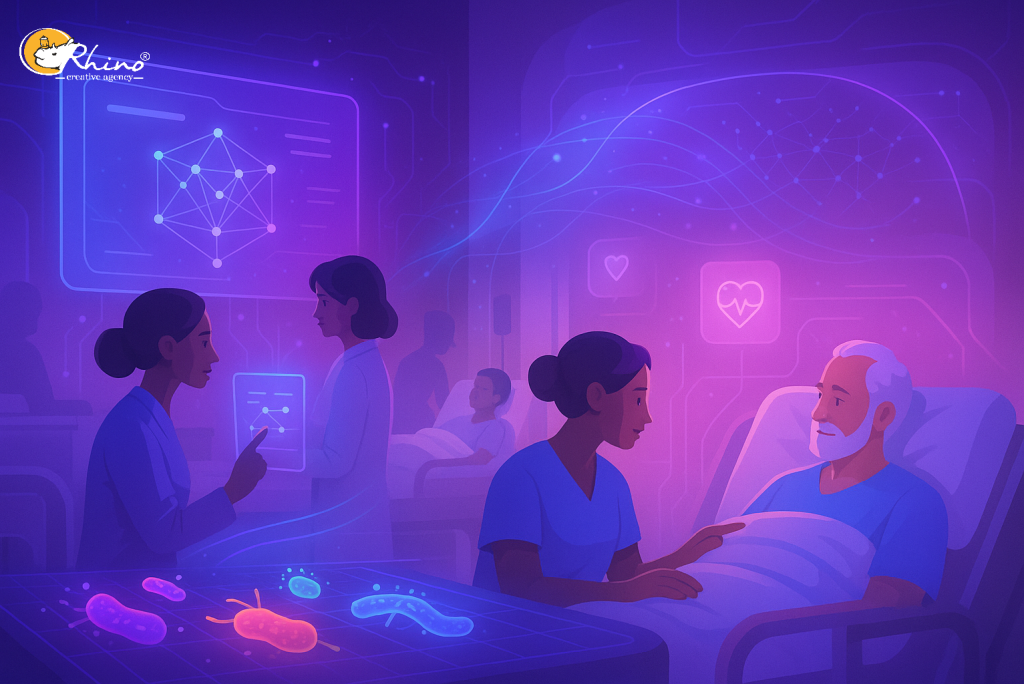1. Introduction
In a world where healthcare demands are skyrocketing—driven by aging populations, chronic disease prevalence, and clinician burnout—Generative AI stands out as a powerful ally. This technology, capable of generating human-like text, images, and more, is increasingly woven into the fabric of patient care. From enhancing diagnostics to streamlining operations, generative AI is reshaping healthcare with precision, empathy, and efficiency.
2. Streamlining Administrative Burdens
Medical professionals often spend more time on paperwork than patient interaction. Generative AI offers a reprieve:
- Clinical Notes & Documentation
AI scribes—powered by speech recognition and language models—automate transcription and create structured clinical notes in formats like SOAP or BIRP. This dramatically cuts documentation time and helps reduce burnout. In fact, four in five UK GPs reported saved time and improved patient rapport thanks to ambient AI-powered scribes . - EHR Data Extraction & Coding
Generative AI can extract structured data from unstructured EHR notes, suggest medical codes, generate discharge instructions, and even draft responses to patient portal messages. These efficiencies free clinicians to focus on what matters: delivering care .
3. Enhancing Diagnostic Accuracy and Speed
- Medical Imaging & Early Detection
Generative models help enhance image quality, detect subtle anomalies in CT scans, X-rays, and MRIs, and automate measurements like lung nodule size—helping clinicians catch diseases like cancer earlier . - Stroke Diagnosis & Outcomes
In the UK’s NHS stroke units, AI now diagnoses strokes over an hour faster than human doctors by analyzing CT scans against large databases, leading to a tripling of recovery rates—from 16% to 48% .
4. Improving Access, Engagement & Personalized Care
- AI Chatbots & Oncology Support
At Vadodara’s SSG Hospital, an AI oncology chatbot now assists patients in Gujarati, Hindi, and English—providing reliable info on treatment, side effects, and post-care via a conversational interface . - Virtual Health Assistants & Remote Monitoring
AI-driven virtual assistants offer 24/7 support—answering queries, scheduling appointments, and reminding patients about medications. Generative AI also powers remote patient-monitoring tools, predicting health deterioration and enabling early intervention . - Patient-Centered Mobile Apps
The mobile app WoundAIssist enables patients to upload wound photos from home, while embedded AI evaluates healing and supports video consultations—bridging care between home and the clinic . - Proactive Risk Prevention
AI analytics embedded in care apps can spot early signs of risk. For example, Cera’s tools have predicted 80% of health risks (preventing ~70% of hospitalizations) and forecast 83% of falls (reducing incidents by 20%) .
5. Accelerating Medical Research and Treatment Development
- Clinical Trial Support
Generative AI is accelerating clinical research by generating patient-facing materials—tailored in language and clarity—as well as helping design trials, selecting participants, and summarizing scientific literature . - Drug Discovery & Synthetic Data
AI simulates molecular structures, predicts drug interactions, and speeds drug discovery. It also creates synthetic patient data for safe research and algorithm validation without breaching privacy .
6. Optimizing Resource Allocation & Reducing Costs
- Administrative Automation & Efficiency
By automating billing, prior authorization, and coding, generative AI reduces administrative costs and accelerates insurance processes . - Predictive Analytics & Resource Planning
AI helps forecast patient admissions, manage staff scheduling, and optimize supply chains, enhancing operational readiness and lowering waste . - Cost Savings Estimates
Business analyses project that AI-driven preventive care could save the U.S. healthcare system up to $150 billion annually by 2026 .
7. Ethical Considerations & Human-AI Collaboration
- Risks of Bias
Generative AI models trained on internet data have exhibited harmful biases—for example, perpetuating incorrect medical stereotypes regarding Black patients’ physiology—which can exacerbate healthcare disparities . Responsible AI use demands rigorous bias audits and diverse, clinical training data. - AI as an Assistant, Not a Replacement
Thought leaders emphasize AI’s role as a support to clinicians. NHS stroke diagnostics, for instance, accelerated decision-making but kept clinicians central. Similarly, news coverage from The Guardian praises AI’s ability to logically extend clinician reach without replacing human judgment . - Transparency, Regulation, Security
Safe AI adoption requires robust regulation, cybersecurity, and transparent governance. Implementations must be continuously evaluated and trusted by practitioners and patients alike .
8. Conclusion
Generative AI is poised to redefine patient care across multiple dimensions: freeing clinicians from administrative overload, improving diagnostic accuracy and speed, expanding access through virtual assistance, aiding research and personalization, and reducing systemic inefficiencies.
However, its success hinges on one essential truth: AI should augment, not replace, human healthcare. When developed ethically, deployed responsibly, and integrated thoughtfully, generative AI can unlock a future of smarter, more compassionate, and more equitable healthcare.

